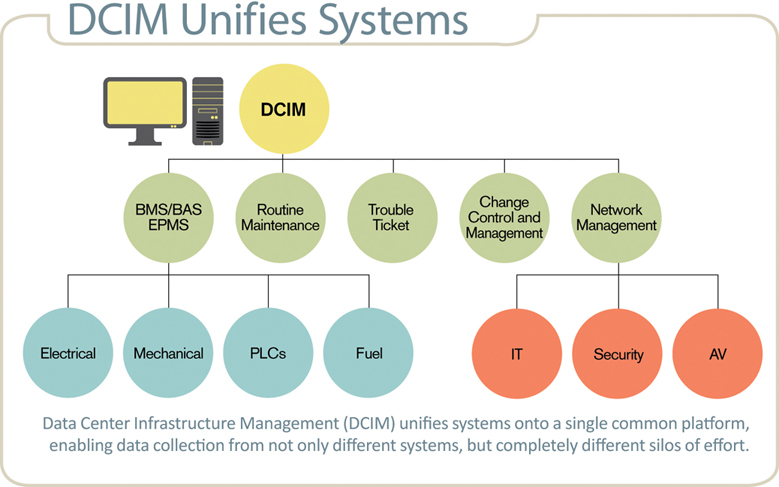What Facility Managers Need to Know to Get the Most Efficiency Out of DCIM
From the facilities perspective, DCIM is a dashboard that can input information from multiple systems and display it on one platform where alert monitoring and manual event correlation can occur. Inputs from fuel tanks, dry contacts, level contacts, sumps, UPS systems, steam humidifiers, routine maintenance systems and more are either brought to their traditional separate monitoring systems and then output into a DCIM, or the DCIM becomes the collection point. Some DCIM systems can control the environment; some simply report on it. A means to monitor systems — which may seem archaic but is still a common practice — involves each system reporting up to a separate control point. While this may be a "smart" building, it's not an intelligent one.
The next step in sophistication is a managed system. Specifying a BMS enables the sharing of systems and infrastructure onto a common platform. While this has traditionally worked very well, DCIM takes this concept further by unifying even more systems, enabling data collection from not only different systems, but completely different silos. (See chart below.) This is what makes a "smart" building an intelligent one.
Why DCIM?
As indicated earlier, the cost and effort associated with the installation and configuration of a DCIM solution could make anyone question the need for it. In addition, most data centers already own substantial amounts of information gathering systems, so why duplicate? The best answer is that while facility managers have a lot of IT systems loaded with information that can communicate with each other, the reality is that these systems often do not.
Data center systems gather information all day long, report anomalies, indicate trouble and even predict events, but they do so in a silo for the most part. Enabling these systems to communicate on a common platform allows that information to get through, be correlated, collaborated, vetted against benchmarks and standards and be proactively utilized across the enterprise. Another benefit to a unified environment is reduced infrastructure cost. When separate, non-integrated — albeit smart — systems are used, separate fibers, copper, pathways, spaces, switches, servers, monitors and software licenses are required. Integrated systems inherently require fewer components.
An installed DCIM solution will permit cross-systems communication, enabling congruent monitoring as an enterprise. A DCIM or middleware tool will provide the facilities side of the business with the metrics needed to further facilitate energy savings and enable intelligent use of the available power and cooling. IT requirements could also include location services interfacing with asset management and control, IT change management systems and building management and testing systems.
In a real world example, IT indicates an upgrade to a core router within their change control system. This system then automatically balances against the scheduled maintenance system managed by facilities personnel and "learns" of a generator test in the same time frame. The DCIM system could then notify both IT and facilities of the possible conflict, allowing each department to determine a different path.
In another example, BMS could alert to a problem with a remote power panel and then indicate this to the DCIM, which in turn could alert the proper IT departments of a potential outage based on who is plugged into that particular panel. This could be performed in a hierarchical model by group, department, team or user and by physical row, cabinet, rack position or server. The responsible IT departments would be able to proactively move their source of power to a more stable one, all done automatically and in real-time.

Related Topics:














